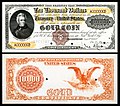United States ten-thousand-dollar bill

The United States 10,000 dollar Bill (US$10000) (1878–1934) is an obsolete denomination of United States currency. The $10,000 note was the highest denomination of US currency to be used by the public. The $10,000 note was discontinued in 1969 but they are still legal tender. The notes are valuable to collectors and since they are still legal tender, banks will redeem the notes for face value.
Description
[edit]The series 1918 version's obverse text reads "Federal Reserve Note" and "The United States of America will pay to the bearer on demand ten thousand dollars".[1] The portrait of Treasury Secretary, Salmon P. Chase appears on the obverse. The $10,000 note was the highest denomination of US currency ever to be used by the public.[2][3] The reverse features a portrait of the early settlers boarding ships. The number 10,000 is printed on the reverse along with the words "Federal Reserve Note".[1] The only higher denomination issued by the United States was the $100,000 but that bill was only used for inter-bank transfers and it did not circulate.[3]
History
[edit]
The United States ten-thousand-dollar bill was printed from 1878 to 1934. The $10,000 notes first appeared in the Series 1878 legal tender notes. It was reissued in the series 1914 and 1918 and in the series 1928 and 1934.[4] The note was originally issued as a gold certificatebut and after the 1933 Executive Order 6102 prohibiting the hoarding of gold currency, the note was redesigned and reissued as a Federal Reserve Note.[4] The Bureau of Engraving and Printing continued to issue the notes until 1969. The notes did not see much circulation among the public because they were printed to facilitate transactions between banks. On July 14, 1969, the United States Department of the Treasury announced that all notes in denominations greater that $100 would be discontinued.[5] Since 1969 banks are required to send any $10,000 bill to the Department of the Treasury for destruction.[6]
Examples of the note are valued by collectors who regularly pay more than $100,000 for graded examples.[7] Many of the surviving notes are in good condition because they did not see much circulation among the public and were used primarily in transfers between banks.[4]
Casino operator Benny Binion displayed one hundred $10,000 bills at his casino, Binion's Gambling Hall and Hotel. The Binion family sold the $10,000 bills in 2016 for amounts between $112,500 and $188,000 each.[8]
In 2023 an example of a 1934 $10,000 bill sold for $480,000 at Heritage Auctions in Texas.[9] The note was an uncirculated example which was graded by the Paper Money Guarantee (PMG) company.[9]
Gallery
[edit]- 1878 $10,000 gold certificate
- 1882 $10,000 gold certificate
- 1917 $10,000 gold certificate
- 1928 $10,000 gold certificate
- 1934 $10,000 gold certificate
References
[edit]- ^ a b "10,000 Dollars, Federal Reserve Note, United States, 1918". americanhistory.si.edu. Smithsonian. Archived from the original on 14 September 2024. Retrieved 13 September 2024.
- ^ Walrath-Holdridge, Mary (21 September 2023). "Talk about inflation: a $10,000 Great Depression-era bill just sold for $480,000". USA Today. Archived from the original on 14 September 2024. Retrieved 13 September 2024.
- ^ a b "$10,000 Bill Museum of American Finance". www.moaf.org. Museum of American Finance. Archived from the original on 14 September 2024. Retrieved 13 September 2024.
- ^ a b c Gilkes, Paul (15 July 2016). "When U.S. paper money denominations included $10,000, even $100,000 notes". CoinWorld. Archived from the original on 14 September 2024. Retrieved 13 September 2024.
- ^ "Bureau of Engraving And Printing". www.bep.gov. The Bureau of Engraving & Printing. Archived from the original on 2023-05-16. Retrieved 2024-09-13.
- ^ "Chapter 5. Federal Reserve Notes". Board of Governors of the Federal Reserve System. Federal Reserve. Archived from the original on 14 September 2024. Retrieved 12 September 2024.
- ^ "PMG-graded High-Dollar Notes in the Spotlight at January Heritage Sale". pmgnotes. Paper Money Guaranty. Archived from the original on 14 September 2024. Retrieved 13 September 2024.
- ^ Brean, Henry (8 January 2016). "Someone wants to spend $188,000 for $10,000 cash". Las Vegas Review-Journal. Archived from the original on 14 September 2024. Retrieved 13 September 2024.
- ^ a b Czachor, Emily Mae (27 September 2023). "$10,000 bill sells for nearly half a million dollars at Texas auction — and 1899 coin sells for almost as much – CBS News". www.cbsnews.com. Archived from the original on 14 September 2024. Retrieved 13 September 2024.


 French
French Deutsch
Deutsch



